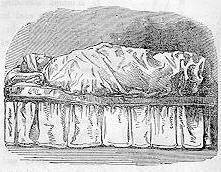Hydropathy, or, The (cold) water cure

The wet sheet pack at Smedley's
There were three major components of the cure as systematised by Vincent Priessnitz, at his Gräffenberg Spa, at Jeseník in what was then Austrian Silesia, in 1822:
- drinking considerable quantities of (usually) mineralized water (as is still the practice in many health spas),
- wet sheet packing, and
- exposing the body to a wide range of specialised showers or douches.
All aspects are admirably, and entertainingly, treated in E S Turner's Taking the cure (London : Michael Joseph, 1967).
Wet sheet packing, shown above in a cut from Practical hydropathy by John Smedley (London : Kent, 1870), involved wrapping the patient in wet sheets for varying periods of time. Initially the patient felt decidedly cold, then merely cool, and finally increasingly warm until s/he broke out in perspiration, rather akin to a fever. Dr Richard Barter deduced that it was actually the feverish perspiration which was responsible for any improvement in the patient's condition, and realised that the Turkish bath, as described by David Urquhart in The Pillars of Hercules (London : Bentley, 1850) was a far more comfortable and enjoyable way of inducing a sweat.
